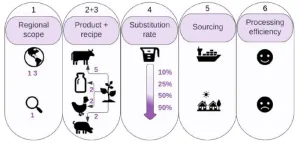(Press-News.org) A major study published in JAMA led by researchers at Karolinska Institutet suggests that a possible cause of spontaneous brain haemorrhage could be transmitted via blood transfusion. At the same time, it is very unlikely that anyone should suffer a brain haemorrhage after receiving donated blood.
A common cause of spontaneous, recurring brain haemorrhages is the vascular disease cerebral amyloid angiopathy (CAA), in which proteins accumulate along the tiny blood vessels of the brain. Several studies have shown that CAA can be transferred from one individual to another through neurosurgery and probably via treatment using a certain type of growth hormone.
Few affected individuals
A new study by researchers from Karolinska Institutet, Södersjukhuset, Karolinska University Hospital in Sweden, the University of Copenhagen in Denmark, KU Leuven in Belgium and other institutions shows that patients who have received blood from donors who later suffered recurring brain haemorrhages are more than twice as likely to suffer a brain haemorrhage themselves.
The findings suggest that some factor that can give rise to spontaneous brain haemorrhages can be spread through blood transfusion. However, as only 0.1 per cent of the donors in the study subsequently suffered recurring brain haemorrhages there were consequently only a few affected patients.
“Blood transfusions are relatively common, which makes possible negative effects an important public health issue,” says the study’s last author Gustaf Edgren, researcher at the Department of Medicine, Karolinska Institutet (Solna) and specialist physician at Södersjukhuset. “However, in this case, it’s very unlikely that you’d suffer a brain haemorrhage from something transmitted through a transfusion.”
CAA could be transmissible
According to the researchers, the most important implication of the study is instead that it adds further support to the hypothesis that CAA can be transmitted between individuals, which, if true, can have consequences in several fields.
The study drew on the Swedish-Danish transfusion database SCANDAT, which contains data on blood donors and patients receiving a transfusion from the 1970s onwards. A total of more than a million patients were included. The primary analyses were conducted in Sweden and then repeated with the Danish data, with almost identical results.
Confirmation needed
The researchers now hope to corroborate the hypothesis that the link between brain haemorrhage and blood transfusion concerns CAA. They will therefore be examining samples from the Danish Blood Donor Study biobank to see if they can identify aberrant proteins associated with the disease.
The plan is also to obtain CAT and MR scans from the affected donors and patients to see if they might also be able to support the hypothesis.
“This study does not demonstrate causality, so the observed increase in risk could depend on other factors,” says the study’s first author Jingcheng Zhao from Dr Edgren’s group at Karolinska Institutet. “More research is needed to confirm our findings and understand the potential underlying mechanism.”
The study was mainly financed by the Swedish Research Council and Region Stockholm (ALF funding). The researchers from KI report no commercial interests (see the paper for a full list of potential conflicts of interest).
Publication: “Intracerebral hemorrhage among blood donors and their transfusion recipients”. Jingcheng Zhao, Klaus Rostgaard, Elsa Lauwers, Torsten Dahlén, Sisse Rye Ostrowski, Christian Erikstrup, Ole Birger Pedersen, Bart De Strooper, Robin Lemmens, Henrik Hjalgrim, Gustaf Edgren. JAMA (Journal of the American Medical Association), online 12 September 2023, doi: 10.1001/jama.2023.14445.
END
Risk of brain hemorrhage appears transmissible via blood transfusion
2023-09-12
ELSE PRESS RELEASES FROM THIS DATE:
Use of antihypertensives, blood pressure, and estimated risk of dementia in late life
2023-09-12
About The Study: This meta-analysis including individual participant data from 34,000 older adults in 17 studies found that antihypertensive use was associated with decreased dementia risk compared with individuals with untreated hypertension through all ages in late life. Individuals with treated hypertension had no increased risk of dementia compared with healthy controls.
Authors: Matthew J. Lennon, M.D., of the University of New South Wales in Sydney, Australia is the corresponding author.
To access the embargoed study: Visit our For The Media website at this link https://media.jamanetwork.com/
(doi: 10.1001/jamanetworkopen.2023.33353)
Editor’s ...
Your body’s own cannabinoid molecules calm you during stress
2023-09-12
·Stress heightens risk for many psychiatric disorders·Finding opens new avenue for drug development to treat psychiatric disorders
·Amygdala releases endogenous cannabinoid molecules under stress
·Finding opens new avenue for drug development to treat psychiatric disorders
CHICAGO --- When you are under stress, your brain may release its own cannabinoid molecules to calm you down, activating the same brain receptors as THC derived from cannabis plants.
But the brain activity patterns and neural circuits that are regulated by these brain-derived ...
Large amounts of sedentary time linked with higher risk of dementia in older adults, study shows
2023-09-12
Adults aged 60 and older who spend more time engaging in sedentary behaviors like sitting while watching TV or driving may be at increased risk of developing dementia, according to a new study by USC and University of Arizona researchers.
Their study showed the risk of dementia significantly increases among adults who spend over 10 hours a day engaging in sedentary behaviors like sitting — a notable finding considering the average American is sedentary for about 9.5 hours each day.
The study, published on Tuesday, September 12 in ...
Plant-based food alternatives could support a shift to global sustainability
2023-09-12
Replacing 50% of meat and milk products with plant-based alternatives by 2050 can reduce agriculture and land use related greenhouse gas (GHG) emissions by 31% and halt the degradation of forest and natural land, according to new research.
According to the study just published in Nature Communications, additional climate and biodiversity benefits could accrue from reforesting land spared from livestock production when meat and milk products are substituted by plant-based alternatives, more than doubling the climate benefits and halving future declines of ...
Study: People who used e-cigarettes before pregnancy were more likely to stop smoking later in pregnancy than those using nicotine replacement therapy
2023-09-12
BUFFALO, N.Y. – The risks of smoking during pregnancy for both maternal and fetal health are well documented, but only about half of pregnant people quit smoking on their own. To learn more about how e-cigarette or nicotine replacement therapy (NRT) influences smoking cessation later in pregnancy, University at Buffalo researchers compared abstinence rates in the two groups. They found that those using e-cigarettes before pregnancy were more likely to abstain from smoking later in pregnancy.
Published in JAMA Network Open on Sept. 12, the research was conducted as an observational study of data gathered from 1,329 pregnant people through the U.S. ...
New rivers in the North? Scientists identify how the dissection of Arctic landscapes is changing with accelerating climate change
2023-09-12
New research co-led by Simon Fraser University and the University of British Columbia shows that amplified global warming in the Canadian High Arctic drove a profound shift in the structure of a river network carved into a permafrost landscape in only 60 years. Documenting a powerful interplay among climate change, the freeze-thaw dynamics of polygonal ground and the delivery of surface water by floods as well as snow and ice melting, the team developed a new view of the physical controls governing the speed and pattern of river channel development in these fragile landscapes.
“One ...
Unveiling dynamics of human macrophage specification during prenatal development
2023-09-12
Researchers led by Prof. LI Hanjie from the Shenzhen Institute of Advanced Technology (SIAT) of the Chinese Academy of Sciences have unveiled the dynamics of human macrophage specification across 19 different tissues from early embryonic stages.
The study was published in Cell on Sept. 12.
Macrophages, i.e., pivotal immune cells, have long been enigmatic in terms of their diversity and roles during human development. Based on findings in rodents, the scientific community has gained some insights into the diversity, developmental origins, and tissue-specific formation of macrophage subtypes. However, it was not clear whether these findings are conserved in humans.
In this ...
Researchers discover genes behind antibiotic resistance in deadly superbug infections
2023-09-12
Researchers discover genes behind antibiotic resistance in deadly superbug infections
Australian researchers have uncovered new genetic insights into Staphylococcus aureus, revealing what makes the bacterium so dangerous when it enters the blood.
While common, Staphylococcus aureus infections – known as Golden staph – can be life-threatening if the bacteria enter the bloodstream, causing sepsis. Golden staph is notorious for its ability to become resistant to antibiotics, making it hard to treat, which can lead to adverse health outcomes for patients infected with a drug-resistant ...
Race and ethnicity and nonpharmacologic care for chronic low back pain
2023-09-12
About The Study: In this study of Medicare beneficiaries with comorbid chronic low back pain and opioid use disorder (OUD), receipt of physical therapy and chiropractic care was low overall and lower across most racial and ethnic minority groups compared with non-Hispanic white persons. The findings underscore the need to address inequities in guideline-concordant pain management, particularly among Black or African American and Hispanic persons with OUD.
Authors: Patience Moyo, Ph.D., of the Brown University School of Public Health in ...
Study of bacteria in day care settings reveals links with children’s lung health
2023-09-12
Milan, Italy: Particular combinations of bacteria found in dust at day care facilities have been linked to wheezing in young children in a study presented at the European Respiratory Society International Congress in Milan, Italy [1]. Wheezing in young children is often an early sign of asthma.
Children may spend many hours in day care each week and research suggests that conditions in day care settings can have an impact on respiratory health in early childhood. The new research offers some clues ...



